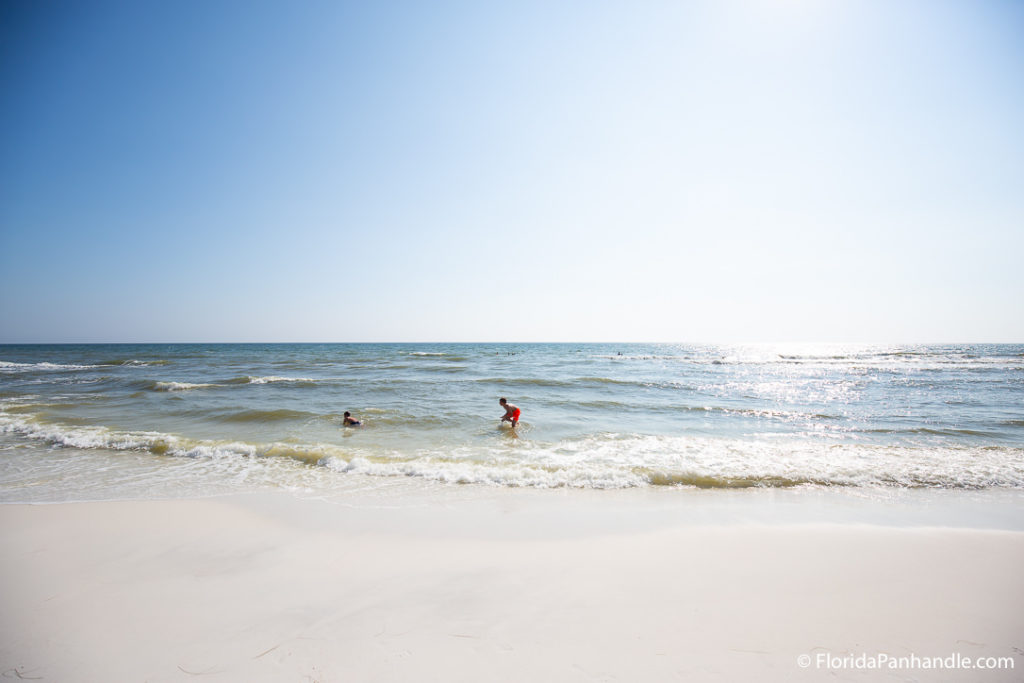Scenic Highway 30A in South Walton is one of the great coastal drives in the Sunshine State. From the charming and architecturally distinctive seashore hamlets to the pinewoods, rare dune lakes, and the Gulf of Mexico vistas, it’s 24 miles of beachfront bliss!
Locals and out-of-towners enjoy these plush sugar sands and postcard views year-round. But what does the weather along this famed two-lane corridor do throughout the year? Is there a better or worse time to visit? Let’s dig into 30A’s meteorological nitty-gritty a bit, shall we?
The Big Picture

In most of Florida, the weather year can be divided between a winter dry season and a summer wet season. That’s somewhat true on the Emerald Coast and the rest of the Florida Panhandle, but it’s less clear-cut here.
That’s because the Panhandle is more exposed to winter cold fronts sweeping in from the north that often bring significant rainfall with them. So even though the Scenic Highway 30A stretch sees its greatest precipitation in the summer—with July and August the wettest months on average—it sees something of a winter wet-season interval, too.
Those winter fronts also bring occasionally quite cold temperatures, though compared to most of the Lower 48 this season is definitely on the balmy side. The coastal climate is also more moderate than even a bit inland on the Panhandle. That’s on account the Gulf of Mexico, like all large bodies of water, warms up and cools down more slowly and less severely than the adjoining land.
Onshore flow in the winter bringing warm, moist air from the Gulf over the chillier land surface sometimes produces fog, particularly at night and in the early morning.
Summers along Scenic Highway 30A are on the hot and muggy side, but more comfortable than interior sites thanks to the Gulf influence. Rainshowers and thunderstorms are common, especially in the afternoon, putting the “wet” in the summer wet season.
The average annual air temperature on this part of the Emerald Coast is about 72 degrees Fahrenheit. The average annual water temperature in the Gulf here is about 75 degrees F.
Average Monthly Temperatures & Precipitation Along Scenic Highway 30A
To give you a more detailed picture of the actual conditions on the Scenic Highway 30A corridor, here are the average temperatures (in degrees F) and rainfall totals for each month.
January
-High: 61
-Low: 42
-Rainfall: 5.0 in.
February
-High: 63
-Low: 45
-Rainfall: 4.0 in.
March
-High: 70
-Low: 52
-Rainfall: 6.0 in.
April
-High: 77
-Low: 60
-Rainfall: 4.5 in.
May
-High: 83
-Low: 66
-Rainfall: 3.4 in.
June
-High: 87
-Low: 71
-Rainfall: 5.2 in.
July
-High: 89
-Low: 74
-Rainfall: 7.2 in.
August
-High: 95
-Low: 74
-Rainfall: 7.0 in.
September
-High: 87
-Low: 70
-Rainfall: 6.8 in.
October
-High: 80
-Low: 60
-Rainfall: 3.2 in.
November
-High: 69
-Low: 50
-Rainfall: 3.4 in.
December
-High: 63
-Low: 44
-Rainfall: 4.0 in.
The water temperatures in the nearshore Gulf, meanwhile, typically range between the mid-60s F in winter and the mid-80s F in late summer.
When Should You Visit Scenic Highway 30A, Weather-wise?

You can have an amazing visit on the 30A stretch of Florida’s Emerald Coast any time of the year. In winter, you’ll want to bring layers for chilly temperatures, which only make a big beach bonfire all the more welcome!
In summer, be prepared to deal with hot weather, with a cooling swim in the Gulf is the perfect remedy. Remember to drink plenty of water, wear a hat and sunscreen, and spend quality time in the shade during the peak heat of the day. Expect spells of rain, and beware of thunderstorms: Ditch the beach and seek shelter in a building or vehicle to protect yourself from lightning.
Whenever you make it down to the 30A, expect dreamy views of white-sand beaches and some fab Gulf of Mexico sunsets: Those are guaranteed, all-season attractions!




